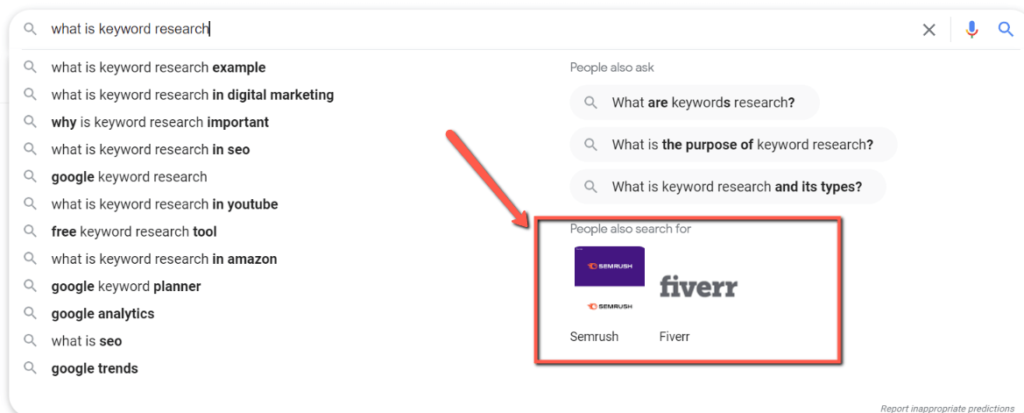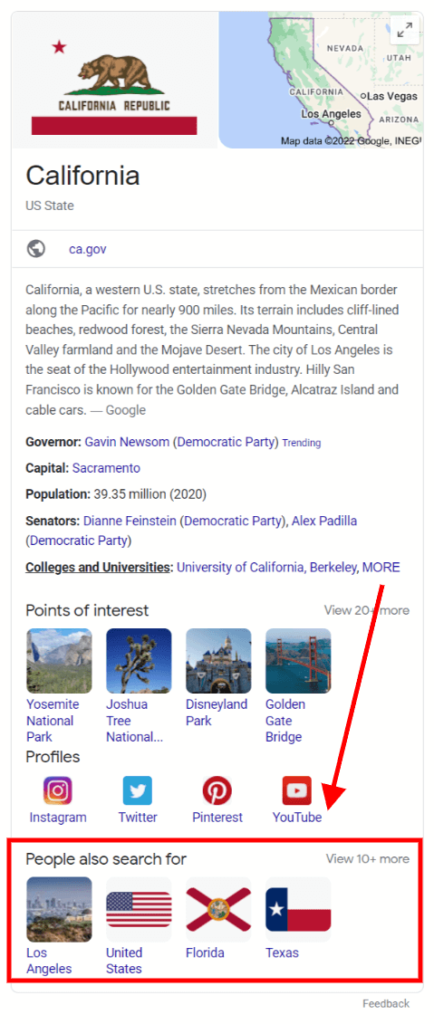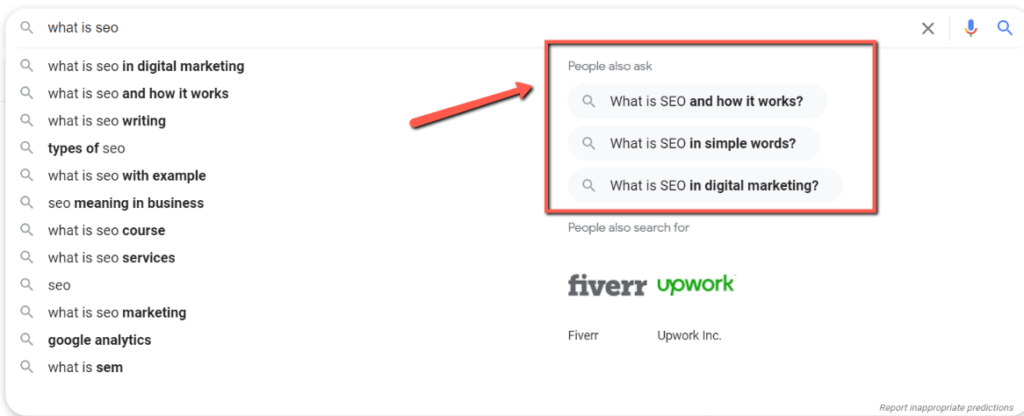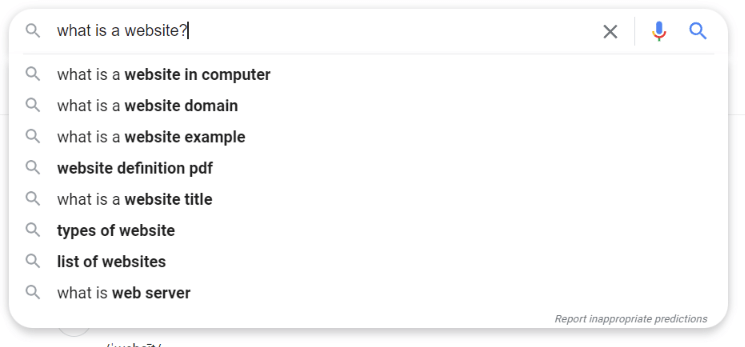Have you ever tried using Google’s People Also Search For feature? If you haven’t, this feature allows you to conduct more detailed research.
The People Also Search tool allows you to see what keywords other people are searching for related to your niche. This helps you discover new keyword ideas that you might never have thought of before.
Those who use the People Also Search tool are usually interested in finding out more information about their topic or category. They want to read articles or watch tutorials from experts in their field.
If you can find a way to combine these two types of searches together, then you will be able to get even better results than if you were only doing one type of search.
“People Also Search For”: What’s The Difference Between People Also Search For and People Also Ask?
People Also Search For is basically a combination of PSA (people also ask) and PASF (people also search for).
This means that when someone does a search on Google, they can choose between asking questions or searching for content.
Here is a screenshot of the People also search box. You can see it right below the search bar. It looks like this:
It shows different brands that people are looking for related to your topic.
You can click on any of the links to view further details on what people are looking for.
It used to be that this would display different suggestions for what people search for, including text. Now, it’s related to branded searches.
Using the People also search box is pretty straightforward. Here is a step-by-step guide to help you along the way.
First, let’s perform a search for something like “California.” You should find a knowledge graph info panel that pops up when the results are displayed:
1. Click on the link titled “People Also Search For…” The following should appear:
Look at the screenshot above.
Now you can see that there are lots of ways to use this tool.
For example, you could search for a particular phrase. Or you could click on the different topics shown under “California/People also search for…” and navigate the
information that Google has about each topic.
If you click on the San Diego card, you will receive search results for San Diego, and so on.
Next, you can narrow down your search by clicking on other search features, including Top stories, more People also ask questions, and the knowledge panel that shows up for the topic.
For this example, you can see the knowledge panel that shows up for San Diego below:
So Then What is “People Also Ask” (PAA)?
PAA, or People Also Ask, is a type of search where it shows questions that people have searched for using related keywords.
It allows users to easily locate relevant information within large bodies of content.
You can use PAA to help boost traffic to your site as well as increase your search visibility for related questions, which can help increase your authority on a given topic.
How Does PAA Work?
1. Type a keyword into the Google search bar.
2. Then, on the search results page, a box will pop down. It will display a “People Also Ask” section that also includes related questions that people have been asking
as part of this particular query.
3. You will see the following boxes appear:
By doing a thorough search analysis, and by using a keyword tool (such as Keywords Everywhere or Wordstream) you can find even more PAA-related keywords to target as part of your SEO efforts.
Using Google’s “People Also Search For” To Improve Your SEO
Google’s PASF feature gives you the ability to rank highly for specific queries. This means that you can create an entirely unique experience for your visitors that goes beyond traditional search results.
To take advantage of this powerful tool, you must first understand what makes it tick.
The following section will walk you through each step of the process, so that you can become familiar with this powerful SEO technique.
Understand How Google Uses PASF Data
In order to use PASF effectively, you must first understand how Google uses data from this feature to determine which websites they think would be most useful to their users.
They do this by analyzing data from previous searches made by other users. So, if someone types in ‘best hotels near me,’ Google will look at all of the searches that were done before yours, and combine them to come up with a list of best-performing sites for that query.
For example, say you wanted to find the best hotel for a vacation. If you did a search for ‘vacation hotels’ you will likely find many results for “vacation hotels,” including those that other users found best fit their search query.
Why “People Also Search For (PASF)” Is Important For SEO
People also search for is important to SEO because it provides valuable insights into what customers are looking for.
These insights help you better understand who your audience is and where they are coming from.
This, in turn, allows you to serve content that will interest them.
And, while you can manually research PASF data, Google makes it easy to access via its API.
So, whether you’re using WordPress, Joomla, Drupal, Magento, Prestashop, or any other CMS, you can quickly obtain this information.
Here are some ways in which PASF data is beneficial for SEO:
1. It tells you what people are searching for.
By identifying keywords that people are actually searching for, you can figure out what products they’re most interested in.
After all, if they’re actively searching for something, chances are good that they’re going to buy it.
2. It reveals what kinds of pages they visit on your site.
If you’re wondering why someone came to your page, they might have come for one reason. They may have read about it online. Or, perhaps, they saw an advertisement for it.
However, there’s another possibility as well: they were browsing around until they stumbled across your page.
In this case, they didn’t even know that it existed. This means that you need to optimize your landing pages so that they’re more likely to come back.
3. It lets you see how frequently people search for certain words.
If your product has a lot of competitors, then you may wonder whether anyone would ever look for your brand name.
However, if you check PASF data using a tool like Keywords Everywhere, you can find out just how many people do actually search for your company name.
4. It shows you which terms are driving traffic to your site.
As we discussed earlier, when someone searches for a keyword, they come to your page.
The question is, which keywords did they choose? If you run a blog, then you can use this information to write posts that rank high on Google.
5. It gives you insight into popular topics.
If you‘re selling widgets, for example, you need to make sure that the widget topic ranks highly in Google.
However, if your business caters to sports fans, you should focus on baseball, basketball, football, and soccer.
By diving into People also search for topics more deeply, it’s possible to identify other related topics people are searching for, and you can make sure that your website covers them.
How to Use “People Also Search For” Data
Now that you understand the importance of PASF data, let’s go over the different ways you can get these insights.
First, you can always rely on Google itself. When you enter a query to Google, it will return results for both People also search for and questions.
For instance, here’s how one could search for “What is a website?”:
You’ll notice that Google provides not only the results of the search, but also a box pops down that reveals other topics people search for.
These are the ones that you might also want to target.
By working with People also search for queries, it’s possible to cover every potential topic that could arise in the course of your article’s discussion.
How to Manage Duplicate PASF Topics
There is a danger of getting too deep into the weeds that you end up with duplicate PASF Topics.
Google doesn’t like duplicates, so it won’t rank them very highly. And if they don’t rank very highly, then they won’t attract any visitors.
Therefore, it’s important to keep an eye on your PASF data and delete or merge duplicate content as soon as you spot it.
How to Use “People Also Search For” Data With Google Trends
When you’re writing an article, try to think about what other people might be looking for.
Once you’ve identified a term that interests you, head over to Google Trends and enter that term.
This tool allows you to compare the popularity of various keywords over time.
If you see a trend, then you’ll know that this word is going to continue growing in popularity.
It’s also a good idea to research similar keywords and their growth trends.
This way you’ll be able to create articles that are related to a specific subject while still being relevant.
PASF data helps you improve your SEO efforts by giving you valuable insights into what people are interested in.
If You’re Stuck Coming Up With New Ideas, Remember To Use Related Searches
Sometimes, even though you have lots of ideas, you may not come up with anything new.
That’s why it’s really useful to remember to use related searches and PASF data.
Related searches tell you what terms people are using right now to find something similar to yours.
And since there are tons of people searching for things related to the ones you offer, you can easily get some traffic from them.
PASF data can help you identify topics within your niche that are trending.
In turn, this makes it much easier to come up with original ideas that aren’t already covered by others.
Now let’s take a look at how we can use all of this information to our advantage.
Start by pulling up Google Trends.
Then click the “More Trending Searches” button near the bottom of the “recently trending” box.
Afterwards, select one of the topics that are currently trending. This will show you what’s currently trending, so that you can now work through the data and figure out which recently trending searches would be best for a deeper dive into your topic.
For example, if you were trying to come up with some ideas for a blog post, you could write down the following phrase: “how to start a business.”
Next, select the location where you’d like to conduct your research.
Finally, click on “Related topics” or “Related queries” to begin your analysis.
As you can see, the results will show you which terms are currently most searched.
The next step is to scroll through the list until you find keyword phrases that you feel would be a great fit for your website.
“People Also Search For” Data Is Not a Magic Bullet
One thing that you should always keep in mind when using PASF data is that it’s not a magic bullet.
While you can certainly increase your chances of getting more traffic by adding these terms to your posts, you shouldn’t expect everything to work out perfectly.
There are many factors involved in determining whether or not a particular keyword is likely to lead to success.
So in addition to using PASF data, make sure to also check out the competition for each term and conduct thorough research as well.















